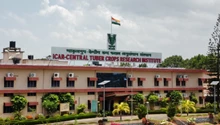
The utilization of drones, satellites, and sensors in agricultural fields has brought about a transformative impact on farming practices worldwide. This technological advancement enables farmers to gain real-time and long-term insights into the condition and progress of their crops.
Due to its capacity to address the biological intricacies and diverse variables within agriculture, including growing conditions, soil types, weather fluctuations, and crop varieties, hyperspectral imaging finds wide-ranging applications across industries such as mineralogy, medical imaging, food quality analysis, and particularly in the agricultural sector.
What is Hyperspectral Imaging?
Among the diverse sources of remote sensing data available, hyperspectral imaging stands out as one of the most information-rich. Unlike traditional imaging that captures only the visible red, green, and blue bands, hyperspectral imaging encompasses the complete electromagnetic spectrum, providing a comprehensive understanding of color and light. Initially developed for military and space applications, hyperspectral imaging has found extensive commercial utility, including in agriculture.
However, the richness of hyperspectral data comes at a price. The continuous collection of data across numerous narrow bands results in voluminous and intricate datasets, posing challenges in terms of storage, costly hardware, operational complexities, and the intricacies of data processing and analysis.
Hyperspectral data are quite large and more complicated than multispectral data, providing considerable obstacles in data handling and interpretation. They are acquired over a large number of narrow bands with continuous spectral coverage.
Hyperspectral Imaging in Agriculture
Over the past two decades, hyperspectral imaging has emerged as a highly promising technique for assessing the quality and safety of agricultural and horticultural products. It combines elements of remote sensing, machine vision, and point spectroscopy to deliver advanced image segmentation for detecting defects and contaminants.
Various crucial applications of hyperspectral imaging in precision agriculture, exploring its current and historical developments, and addressing important issues to foster end-user solutions aligned with global sustainability objectives have assisted users in this field.
Potential Applications of Hyperspectral Imaging in Agriculture
-
Precision Nutrition and Fertilization: Utilizing hyperspectral imaging to monitor and optimize crop nutrition, including essential macro and micronutrients such as phosphorus (P), potassium (K), magnesium (Mg), manganese (Mn), copper (Cu), and zinc (Zn).
-
Early Detection of Diseases and Stress: Leveraging hyperspectral imaging to identify and detect diseases and stress factors at an early stage, such as citrus greening, enabling timely interventions for disease management.
-
Biophysical Indicators for Plant Breeding: Employing hyperspectral imaging to measure biophysical indicators like leaf area index (LAI), biomass, yield, and density, facilitating high-throughput phenotyping to support plant breeding experiments and enhance breeding efficiency.
-
Species and Genotype Discrimination: Leveraging the spectral characteristics provided by hyperspectral imaging for accurate discrimination of plant species, vegetation types, and different genotypes within crops.
-
Analysis of Biochemical Properties: Utilizing hyperspectral imaging to analyze biochemical properties such as anthocyanins, carotenoids, and chlorophyll content, providing insights into the physiological status and health of crops.
In conclusion, hyperspectral remote sensing holds immense value in agriculture due to its ability to provide detailed and comprehensive information about crops and their growing conditions. It enables precise monitoring of crop nutrition, early detection of diseases and stress factors, and facilitates high-throughput phenotyping for efficient plant breeding. Moreover, hyperspectral imaging aids in species and genotype discrimination and offers valuable insights into the biochemical properties of crops, contributing to enhanced agricultural management practices and improved crop productivity.











